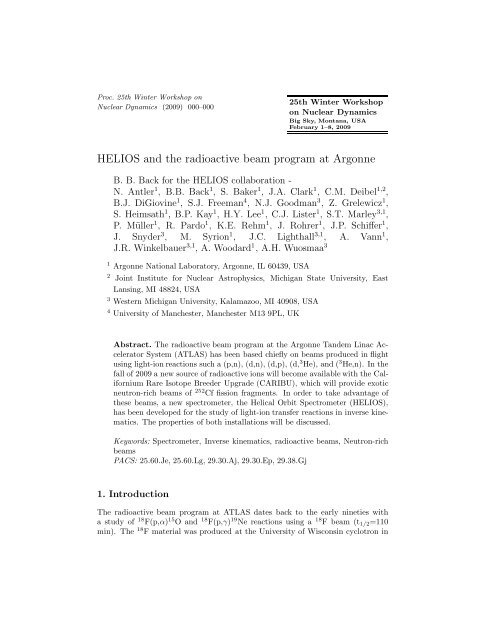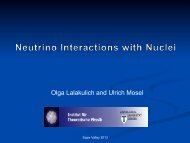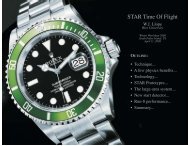HELIOS and the radioactive beam program at Argonne
HELIOS and the radioactive beam program at Argonne
HELIOS and the radioactive beam program at Argonne
Create successful ePaper yourself
Turn your PDF publications into a flip-book with our unique Google optimized e-Paper software.
Proc. 25th Winter Workshop on<br />
Nuclear Dynamics (2009) 000–000<br />
25th Winter Workshop<br />
on Nuclear Dynamics<br />
Big Sky, Montana, USA<br />
February 1–8, 2009<br />
<strong>HELIOS</strong> <strong>and</strong> <strong>the</strong> <strong>radioactive</strong> <strong>beam</strong> <strong>program</strong> <strong>at</strong> <strong>Argonne</strong><br />
B. B. Back for <strong>the</strong> <strong>HELIOS</strong> collabor<strong>at</strong>ion -<br />
N. Antler 1 , B.B. Back 1 , S. Baker 1 , J.A. Clark 1 , C.M. Deibel 1,2 ,<br />
B.J. DiGiovine 1 , S.J. Freeman 4 , N.J. Goodman 3 , Z. Grelewicz 1 ,<br />
S. Heims<strong>at</strong>h 1 , B.P. Kay 1 , H.Y. Lee 1 , C.J. Lister 1 , S.T. Marley 3,1 ,<br />
P. Müller 1 , R. Pardo 1 , K.E. Rehm 1 , J. Rohrer 1 , J.P. Schiffer 1 ,<br />
J. Snyder 3 , M. Syrion 1 , J.C. Lighthall 3,1 , A. Vann 1 ,<br />
J.R. Winkelbauer 3,1 , A. Woodard 1 , A.H. Wuosmaa 3<br />
1 <strong>Argonne</strong> N<strong>at</strong>ional Labor<strong>at</strong>ory, <strong>Argonne</strong>, IL 60439, USA<br />
2 Joint Institute for Nuclear Astrophysics, Michigan St<strong>at</strong>e University, East<br />
Lansing, MI 48824, USA<br />
3 Western Michigan University, Kalamazoo, MI 40908, USA<br />
4 University of Manchester, Manchester M13 9PL, UK<br />
Abstract. The <strong>radioactive</strong> <strong>beam</strong> <strong>program</strong> <strong>at</strong> <strong>the</strong> <strong>Argonne</strong> T<strong>and</strong>em Linac Acceler<strong>at</strong>or<br />
System (ATLAS) has been based chiefly on <strong>beam</strong>s produced in flight<br />
using light-ion reactions such a (p,n), (d,n), (d,p), (d, 3 He), <strong>and</strong> ( 3 He,n). In <strong>the</strong><br />
fall of 2009 a new source of <strong>radioactive</strong> ions will become available with <strong>the</strong> Californium<br />
Rare Isotope Breeder Upgrade (CARIBU), which will provide exotic<br />
neutron-rich <strong>beam</strong>s of 252 Cf fission fragments. In order to take advantage of<br />
<strong>the</strong>se <strong>beam</strong>s, a new spectrometer, <strong>the</strong> Helical Orbit Spectrometer (<strong>HELIOS</strong>),<br />
has been developed for <strong>the</strong> study of light-ion transfer reactions in inverse kinem<strong>at</strong>ics.<br />
The properties of both install<strong>at</strong>ions will be discussed.<br />
Keywords: Spectrometer, Inverse kinem<strong>at</strong>ics, <strong>radioactive</strong> <strong>beam</strong>s, Neutron-rich<br />
<strong>beam</strong>s<br />
PACS: 25.60.Je, 25.60.Lg, 29.30.Aj, 29.30.Ep, 29.38.Gj<br />
1. Introduction<br />
The <strong>radioactive</strong> <strong>beam</strong> <strong>program</strong> <strong>at</strong> ATLAS d<strong>at</strong>es back to <strong>the</strong> early nineties with<br />
a study of 18 F(p,α) 15 O <strong>and</strong> 18 F(p,γ) 19 Ne reactions using a 18 F <strong>beam</strong> (t 1/2 =110<br />
min). The 18 F m<strong>at</strong>erial was produced <strong>at</strong> <strong>the</strong> University of Wisconsin cyclotron in
2 B.B.Back et al.<br />
Madison, Wisconsin via <strong>the</strong> 18 O(p,n) reaction, chemically extracted <strong>and</strong> transported<br />
to <strong>Argonne</strong> in a small plane <strong>and</strong> inserted into <strong>the</strong> ATLAS ion source for acceler<strong>at</strong>ion.<br />
This two-acceler<strong>at</strong>or method has been used only for a few, sufficiently long-lived<br />
isotopes, such as 18 F [1], 56 Ni [2], <strong>and</strong> 44 Ti [3]. Subsequently an in-flight production<br />
method has been used to produce a large number of <strong>radioactive</strong> <strong>beam</strong>s by interacting<br />
stable <strong>beam</strong>s with p, d, <strong>and</strong> 3 He in a small, cooled gas target <strong>and</strong> transporting <strong>the</strong><br />
reaction products from few nucleon transfer reactions to <strong>the</strong> experimental st<strong>at</strong>ion<br />
for studies of reactions, mostly of astrophysical interest [4]. The l<strong>at</strong>est scheme for<br />
obtaining <strong>radioactive</strong> ions for nuclear structure <strong>and</strong> astrophysics studies involves<br />
<strong>the</strong> capture of fission fragments from a strong spontaneous fissioning 252 Cf source<br />
in CARIBU, as described in <strong>the</strong> following section. In order to take full advantage of<br />
both <strong>the</strong>se <strong>and</strong> <strong>the</strong> in-flight <strong>beam</strong>s, a new spectrometer, <strong>HELIOS</strong>, has been built,<br />
which allows for optimal use of <strong>the</strong>se <strong>beam</strong>s in inverse kinem<strong>at</strong>ics studies of few<br />
nucleon transfer reactions.<br />
Transport<br />
cask<br />
Shielding<br />
Gas cell<br />
RFQ<br />
coolers<br />
Quadrupoles<br />
252 Cf source<br />
High resolution<br />
mass spectrometer<br />
High voltage<br />
pl<strong>at</strong>form<br />
Low energy <strong>beam</strong><br />
Switching<br />
magnet<br />
To ECR charge breeder<br />
Fig. 1. Schem<strong>at</strong>ic view of <strong>the</strong> arrangement on <strong>the</strong> CARIBU high-voltage pl<strong>at</strong>form<br />
(V < 200 KV). The individual components are labeled in <strong>the</strong> figure. The 252 Cf<br />
source is shown in two positions <strong>and</strong> <strong>the</strong> shielding is shown in its open position<br />
allowing for <strong>the</strong> source transfer.<br />
2. CARIBU<br />
The CARIBU injector (see Fig. 1 <strong>and</strong> Ref. [5]), which will start oper<strong>at</strong>ion in <strong>the</strong> fall<br />
of 2009, is based on a strong, up to 1 Ci, 252 Cf source, which emits about 10 9 fission<br />
fragments per second of very neutron-rich nuclei into <strong>the</strong> forward hemisphere, where<br />
<strong>the</strong>y are stopped in a high-efficiency gas cell <strong>and</strong> extracted as 1 + ions. The ions<br />
are subsequently cooled in an RFQ cooler <strong>and</strong> mass selected in a m/∆m=20,000
<strong>HELIOS</strong> ... 3<br />
isobar mass separ<strong>at</strong>or. Singly-charged ions may be transported into a low-energy<br />
<strong>beam</strong>-line for study of nuclear properties such as precise measurements of masses in<br />
<strong>the</strong> Canadian Penning Trap (CPT), nuclear moments <strong>and</strong> charge distributions in a<br />
future co-linear laser setup, or decay properties using a tape transport system with<br />
γ,β detection of short-lived activities. Altern<strong>at</strong>ively <strong>the</strong> singly-charged ion <strong>beam</strong><br />
may be injected into a modified ECR source for charge breeding <strong>and</strong> extracted as<br />
highly charged ions for fur<strong>the</strong>r acceler<strong>at</strong>ion in ATLAS. These high-quality exotic<br />
<strong>beam</strong>s may <strong>the</strong>refore be utilized in all <strong>the</strong> ATLAS experimental st<strong>at</strong>ions.<br />
3. Why inverse kinem<strong>at</strong>ics?<br />
Much of <strong>the</strong> nuclear structure inform<strong>at</strong>ion available today has been obtained by<br />
light-ion reactions on st<strong>at</strong>ionary nuclear targets performed in so-called normal kinem<strong>at</strong>ics.<br />
Examples are studies of <strong>the</strong> single-particle strength in nucleon stripping<br />
(d,p), ( 3 He,d) or pick-up (p,d), (d, 3 He), ( 3 He,α) reactions, which have been used to<br />
explore <strong>the</strong> single particle/hole strength <strong>and</strong> spectroscopic factors in practically all<br />
nuclear species th<strong>at</strong> can be reached with stable or long-lived targets. This detailed<br />
inform<strong>at</strong>ion is, however, by n<strong>at</strong>ure concentr<strong>at</strong>ed along <strong>the</strong> line of β-stability because<br />
of <strong>the</strong> target limit<strong>at</strong>ions.<br />
Fig. 2. Left panel: Illustr<strong>at</strong>ion of inverse <strong>and</strong> normal kinem<strong>at</strong>ics for a (d,p)<br />
reaction with a heavy nucleus. Right panel: The labor<strong>at</strong>ory energy of protons<br />
emitted from <strong>the</strong> 28 Si(d,p) reaction in ei<strong>the</strong>r normal (gently sloping curves) or<br />
inverse (strongly sloping curves) kinem<strong>at</strong>ics is shown as a function of labor<strong>at</strong>ory<br />
angle, θ lab. The corresponding range of center-of-mass angles, θ cm, is indic<strong>at</strong>ed.<br />
In recent years, transfer reaction studies have been extended to <strong>radioactive</strong><br />
species by using inverse kinem<strong>at</strong>ics, i.e. with heavy <strong>radioactive</strong> <strong>beam</strong>s impinging<br />
onto light solid targets containing deuterons or protons, or gas targets of Helium<br />
or Hydrogen isotopes. With <strong>the</strong> prospect of more precision <strong>radioactive</strong> <strong>beam</strong>s becoming<br />
available in <strong>the</strong> near future it is anticip<strong>at</strong>ed th<strong>at</strong> such transfer reactions
4 B.B.Back et al.<br />
performed in inverse kinem<strong>at</strong>ics will play a central role in advancing our underst<strong>and</strong>ing<br />
of nuclei far from stability; first with rel<strong>at</strong>ively weak <strong>beam</strong>s from HRIBF<br />
<strong>at</strong> ORNL, ISAC-2 <strong>at</strong> TRIUMF, Rex-Isolde <strong>at</strong> CERN, ReA-3 <strong>at</strong> NSCL, Spiral-2 <strong>at</strong><br />
GANIL <strong>and</strong> CARIBU <strong>at</strong> ATLAS, but on a longer time scale abundant <strong>beam</strong>s from<br />
FRIB will substantially exp<strong>and</strong> <strong>the</strong> range of nuclear transfer reaction studies.<br />
The inverse kinem<strong>at</strong>ics method carries with it, however, substantial obstacles for<br />
obtaining sufficient energy resolution to be able to separ<strong>at</strong>e adjacent nuclear st<strong>at</strong>es<br />
when <strong>the</strong> ejectiles are measured as a function of emission angle. In many cases, <strong>the</strong><br />
forward angles in <strong>the</strong> center-of-mass system correspond to very backward sc<strong>at</strong>tering<br />
angles in <strong>the</strong> labor<strong>at</strong>ory, where kinem<strong>at</strong>ical compression of <strong>the</strong> nuclear st<strong>at</strong>es into<br />
a small energy interval can be quite severe as illustr<strong>at</strong>ed in Fig. 2. This effect<br />
limits <strong>the</strong> achievable Q-value resolution <strong>and</strong> <strong>the</strong> ability to identify particles using<br />
<strong>the</strong> st<strong>and</strong>ard ∆E-E technique. At first glance, <strong>the</strong>se experimental limit<strong>at</strong>ions would<br />
appear to severely limit <strong>the</strong> utility of transfer reaction studies using <strong>radioactive</strong><br />
<strong>beam</strong>s. As explained in <strong>the</strong> following section, <strong>the</strong>se problems can be overcome by<br />
employing a new concept in which <strong>the</strong> ejectiles are transported back to <strong>the</strong> <strong>beam</strong><br />
axis in a homogeneous magnetic field aligned with <strong>the</strong> <strong>beam</strong> axis, a method th<strong>at</strong> is<br />
realized in <strong>the</strong> recently commissioned <strong>HELIOS</strong> spectrometer <strong>at</strong> ATLAS.<br />
Fig. 3. Schem<strong>at</strong>ic illustr<strong>at</strong>ion of <strong>the</strong> <strong>HELIOS</strong> concept. From <strong>the</strong> left, <strong>the</strong> <strong>beam</strong><br />
enters <strong>the</strong> homogeneous, axial field region through <strong>the</strong> hollow Si detector array.<br />
Backward-going charged particles follow helical trajectories <strong>and</strong> are intercepted by<br />
<strong>the</strong> position-sensitive Si detector before returning to <strong>the</strong> <strong>beam</strong> axis. Coincidences<br />
with recoils detected in a forward detector may be used, if needed.<br />
4. The <strong>HELIOS</strong> concept<br />
The basic principle of this spectrometer [6] is th<strong>at</strong> in a sufficiently strong, homogeneous,<br />
longitudinal magnetic field B, charged particles with mass m <strong>and</strong> charge<br />
q, emerging from <strong>the</strong> <strong>beam</strong>-target interaction point, will follow helical trajectories
<strong>HELIOS</strong> ... 5<br />
<strong>and</strong> return to <strong>the</strong> <strong>beam</strong> axis after <strong>the</strong> cyclotron period<br />
t cyc = 2π m<br />
B qe , (1)<br />
where e is <strong>the</strong> unit charge. By placing a hollow, position-sensitive Si-detector array<br />
(see Fig. 3) to intercept <strong>the</strong> particles before <strong>the</strong>y reach <strong>the</strong> <strong>beam</strong> axis, <strong>the</strong>ir energy,<br />
E, flight-time, t, <strong>and</strong> position, z, can be measured.<br />
These measured quantities determine completely <strong>the</strong> kinem<strong>at</strong>ic parameters of<br />
2-body reactions. The flight-time provides particle identific<strong>at</strong>ion via <strong>the</strong> cyclotron<br />
period, Eq. 1, <strong>and</strong> <strong>the</strong> center-of-mass energy is given by<br />
E cm = E + m 2 V cm 2 − mV cmz<br />
, (2)<br />
t cyc<br />
where V cm <strong>and</strong> z are <strong>the</strong> velocity of <strong>the</strong> center-of-mass system, <strong>and</strong> <strong>the</strong> intercept<br />
position, respectively. V cm <strong>and</strong> z, along with <strong>the</strong> measured energy, E lab , determine<br />
<strong>the</strong> center-of-mass sc<strong>at</strong>tering angle, θ cm . The fact th<strong>at</strong> <strong>the</strong> energy in <strong>the</strong> centerof-mass<br />
system equals <strong>the</strong> measured labor<strong>at</strong>ory energy plus a constant offset, when<br />
measured <strong>at</strong> a fixed axial position, z, illustr<strong>at</strong>es <strong>the</strong> second important property<br />
of <strong>HELIOS</strong>, namely th<strong>at</strong> <strong>the</strong> kinem<strong>at</strong>ic compression is elimin<strong>at</strong>ed. This property<br />
allows for improved Q-value resolution in inverse kinem<strong>at</strong>ics measurements, which<br />
use heavy <strong>radioactive</strong> <strong>beam</strong>s impinging on light H <strong>and</strong> He targets. Finally, <strong>the</strong> fact<br />
th<strong>at</strong> particles return to <strong>the</strong> <strong>beam</strong> axis means th<strong>at</strong> only a rel<strong>at</strong>ively small area needs<br />
to be covered with position sensitive Si detectors. A large acceptance can <strong>the</strong>refore<br />
be obtained <strong>at</strong> a moder<strong>at</strong>e cost <strong>and</strong> complexity of <strong>the</strong> detection system.<br />
5. Building <strong>HELIOS</strong><br />
The large, homogeneous magnetic field volume needed for <strong>the</strong> <strong>HELIOS</strong> spectrometer<br />
is provided by a 3 T superconducting solenoid obtained from a de-commissioned<br />
Magnetic Resonance Imaging magnet. The solenoid is installed in <strong>the</strong> former general<br />
purpose area <strong>at</strong> ATLAS such th<strong>at</strong> <strong>the</strong> magnetic field axis coincides with <strong>the</strong> <strong>beam</strong><br />
line. The 90 cm diameter warm bore of <strong>the</strong> magnet is enclosed by large end-flanges,<br />
which provides a vacuum enclosure th<strong>at</strong> serves as <strong>the</strong> target chamber. The <strong>beam</strong><br />
enters via a 1 cm diameter hole through <strong>the</strong> Si detector array support rod, which<br />
is clad on <strong>the</strong> outside with twenty-four 1 x 5 cm 2 position sensitive Si detectors. It<br />
is planned to upgrade <strong>the</strong> Si detector array to forty 2 x 5 cm 2 wafers in order to<br />
achieve almost 100% azimuthal acceptance over a length of >60 cm. The position of<br />
a particle impact is obtained by charge division in <strong>the</strong> resistive front electrode of <strong>the</strong><br />
detectors. A fan-like structure supports up to nine targets, which can be selected<br />
by rot<strong>at</strong>ion of <strong>the</strong> mounting rail loc<strong>at</strong>ed <strong>at</strong> <strong>the</strong> bottom of <strong>the</strong> magnet bore. The<br />
position of <strong>the</strong> target fan <strong>and</strong> <strong>the</strong> Si detector array can independently be adjusted<br />
longitudinally. Combined with magnetic field settings up to a maximum of 3 T, this<br />
allows for optimal coverage of excit<strong>at</strong>ion energy <strong>and</strong> sc<strong>at</strong>tering angle of interest. A<br />
three-dimensional engineering drawing cut-through of <strong>the</strong> setup is shown in Fig. 4.
6 B.B.Back et al.<br />
Fig. 4. Cut-through of <strong>the</strong> <strong>HELIOS</strong> spectrometer showing <strong>the</strong> end-flanges, <strong>the</strong><br />
angle-adjustable supports for <strong>the</strong> Si-detector array, <strong>and</strong> <strong>the</strong> target-fan mounted<br />
off <strong>the</strong> rot<strong>at</strong>able rail <strong>at</strong> <strong>the</strong> bottom of <strong>the</strong> magnet bore.<br />
6. First results<br />
The spectrometer was commissioned in August 2008 using a stable 28 Si <strong>beam</strong> incident<br />
upon an 84 µg/cm 2 CD 2 target to measure single neutron st<strong>at</strong>es in 28 Si using<br />
<strong>the</strong> d( 28 Si,p) reaction. The magnetic field was 1.915 T. Fig. 5 shows a 2-dimensional<br />
spectrum of <strong>the</strong> proton energy, E p , versus <strong>the</strong> longitudinal position z p (<strong>the</strong> distance<br />
from <strong>the</strong> target) for several longitudinal target positions. The top diagonal trace<br />
corresponds to <strong>the</strong> ground st<strong>at</strong>e of 29 Si. Several excited st<strong>at</strong>es are visible <strong>at</strong> lower<br />
energies. Note th<strong>at</strong> <strong>the</strong>se traces are parallel, as expected on <strong>the</strong> basis of Eq. 2.<br />
The horizontal lines correspond to α contamin<strong>at</strong>ion from a 228 Th source used for<br />
an energy calibr<strong>at</strong>ion of <strong>the</strong> detectors <strong>at</strong> <strong>the</strong> beginning of <strong>the</strong> experiment. Fig. 6<br />
shows <strong>the</strong> excit<strong>at</strong>ion spectrum of 29 Si integr<strong>at</strong>ed over a wide range of angles. The<br />
energy resolution is clearly demonstr<strong>at</strong>ed by <strong>the</strong> fact th<strong>at</strong> <strong>the</strong> E x =6.19 <strong>and</strong> 6.38<br />
MeV st<strong>at</strong>es are well separ<strong>at</strong>ed.<br />
This commissioning experiment clearly valid<strong>at</strong>es <strong>the</strong> basic oper<strong>at</strong>ing principle of<br />
<strong>the</strong> <strong>HELIOS</strong> spectrometer. The preserv<strong>at</strong>ion of good energy resolution for inverse<br />
kinem<strong>at</strong>ic reactions will be of central importance for exploring charged particle
<strong>HELIOS</strong> ... 7<br />
Fig. 5. The energy of protons, E p, is plotted vs. z p for <strong>the</strong> d( 28 Si,p) reaction. The<br />
diagonal traces represent st<strong>at</strong>es in 29 Si, whereas horizontal lines arise from a shortlived<br />
α-contamin<strong>at</strong>ion in <strong>the</strong> chamber. Horizontal gaps of about 1 cm between<br />
<strong>the</strong> detectors are evident, <strong>and</strong> a proton background from fusion-evapor<strong>at</strong>ion on<br />
<strong>the</strong> carbon in <strong>the</strong> CD 2 target is seen.<br />
reactions with heavy <strong>radioactive</strong> <strong>beam</strong>s, such as those becoming available from <strong>the</strong><br />
CARIBU injector <strong>at</strong> ATLAS in <strong>the</strong> near future.<br />
7. Conclusions<br />
In this paper we have given a historical perspective on <strong>the</strong> <strong>radioactive</strong> <strong>beam</strong> <strong>program</strong><br />
<strong>at</strong> ATLAS. This work has been ongoing for over a decade, starting with <strong>beam</strong>s<br />
obtained from rel<strong>at</strong>ively long-lived activities produced <strong>at</strong> o<strong>the</strong>r acceler<strong>at</strong>ors, <strong>and</strong><br />
continuing with a very productive <strong>program</strong> with in-flight produced <strong>radioactive</strong>, but<br />
rel<strong>at</strong>ively light, <strong>beam</strong>s th<strong>at</strong> have been used mostly for nuclear astrophysics studies.<br />
With <strong>the</strong> new CARIBU injector, which will be commissioned in <strong>the</strong> summer/fall of<br />
2009, <strong>the</strong> range of <strong>radioactive</strong> <strong>beam</strong>s will be exp<strong>and</strong>ed to include very neutron-rich<br />
fragments from spontaneous fission of a strong, 1 Ci, 252 Cf source. In order to<br />
use <strong>the</strong>se <strong>beam</strong>s for transfer reaction studies, a new type of spectrometer has been<br />
built, which is ideally suited for <strong>the</strong> study of such reactions in inverse kinem<strong>at</strong>ics. It<br />
is expected th<strong>at</strong> <strong>the</strong> CARIBU injector <strong>and</strong> <strong>the</strong> <strong>HELIOS</strong> spectrometer will allow for<br />
a wide range of detailed studies of <strong>the</strong> nuclear structure in <strong>the</strong> neutron-rich region<br />
of heavy nuclei from CARIBU as well as nuclear astrophysics studies with <strong>beam</strong>s<br />
produced via <strong>the</strong> in-flight method.
8 B.B.Back et al.<br />
Fig. 6. Excit<strong>at</strong>ion energy spectrum of protons from <strong>the</strong> d( 28 Si,p) reaction. A<br />
subtraction of <strong>the</strong> background from reactions on <strong>the</strong> carbon in <strong>the</strong> target has<br />
been performed.<br />
Acknowledgments<br />
This work was supported by <strong>the</strong> U.S. Department of Energy, Office of Nuclear<br />
Physics under contracts DE-AC02-06CH11357 <strong>and</strong> DE-FG02-04ER41320 <strong>and</strong> <strong>the</strong><br />
N<strong>at</strong>ional Science Found<strong>at</strong>ion under grant PHY-08-22648 (JINA).<br />
References<br />
1. K.E. Rehm et al., Phys. Rev. C52, R460 (1995); Phys. Rev. C53, 1950 (1996);<br />
Phys. Rev. C55, R566 (1997)<br />
2. K.E. Rehm et al., Phys. Rev. Lett. 80, 676 (1998)<br />
3. A. Sonzogni et al., Phys. Rev. Lett. 84, 1651 (2000)<br />
4. K.E. Rehm et al., Phys. Rev. Lett. 81, 3341 (1998)<br />
5. G. Savard, S. Baker, C. Davids, A.F. Lev<strong>and</strong>, E.F. Moore, R.C. Pardo, R.<br />
Vondrasek, B.J. Zabransky, G. Zinkann, Nucl. Instrum. Methods B266, 4086<br />
(2008)<br />
6. A.H. Wuosmaa, J.P. Schiffer, B.B. Back, C.J. Lister, K.E. Rehm., Nucl.<br />
Instrum. Methods A580, 1290 (2007)





